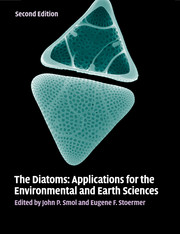Book contents
- Frontmatter
- Contents
- List of contributors
- Preface
- Part I Introduction
- Part II Diatoms as indicators of environmental change in flowing waters and lakes
- Part III Diatoms as indicators in Arctic, Antarctic, and alpine lacustrine environments
- Part IV Diatoms as indicators in marine and estuarine environments
- 15 Diatoms and environmental change in large brackish-water ecosystems
- 16 Applied diatom studies in estuaries and shallow coastal environments
- 17 Estuarine paleoenvironmental reconstructions using diatoms
- 18 Diatoms on coral reefs and in tropical marine lakes
- 19 Diatoms as indicators of former sea levels, earthquakes, tsunamis, and hurricanes
- 20 Marine diatoms as indicators of modern changes in oceanographic conditions
- 21 Holocene marine diatom records of environmental change
- 22 Diatoms as indicators of paleoceanographic events
- 23 Reconsidering the meaning of biogenic silica accumulation rates in the glacial Southern Ocean
- Part V Other applications
- Part VI Conclusions
- Glossary, acronyms, and abbreviations
- Index
- References
19 - Diatoms as indicators of former sea levels, earthquakes, tsunamis, and hurricanes
from Part IV - Diatoms as indicators in marine and estuarine environments
Published online by Cambridge University Press: 05 June 2012
- Frontmatter
- Contents
- List of contributors
- Preface
- Part I Introduction
- Part II Diatoms as indicators of environmental change in flowing waters and lakes
- Part III Diatoms as indicators in Arctic, Antarctic, and alpine lacustrine environments
- Part IV Diatoms as indicators in marine and estuarine environments
- 15 Diatoms and environmental change in large brackish-water ecosystems
- 16 Applied diatom studies in estuaries and shallow coastal environments
- 17 Estuarine paleoenvironmental reconstructions using diatoms
- 18 Diatoms on coral reefs and in tropical marine lakes
- 19 Diatoms as indicators of former sea levels, earthquakes, tsunamis, and hurricanes
- 20 Marine diatoms as indicators of modern changes in oceanographic conditions
- 21 Holocene marine diatom records of environmental change
- 22 Diatoms as indicators of paleoceanographic events
- 23 Reconsidering the meaning of biogenic silica accumulation rates in the glacial Southern Ocean
- Part V Other applications
- Part VI Conclusions
- Glossary, acronyms, and abbreviations
- Index
- References
Summary
Introduction
The significance of relative sea level during the late Quaternary is recognized by disciplines across the Earth sciences. Sea-level histories are important for calibrating and constraining geophysical models of Earth's rheology and glacio-isostatic adjustment (e.g. Peltier, 2004). Sea level is crucial to any study of coastal evolution as it serves as the ultimate baseline for continental denudation (Summerfield, 1991). For human populations, sea levels during the late Quaternary have been an important factor in sustaining coastal communities and may have profoundly influenced the very initiation of human civilization (e.g. Turney and Brown, 2007). Publication of reports from the Intergovernmental Panel on Climate Change (IPCC, 2007) re-emphasized the importance of sea level as a barometer of climate and drew attention to the potentially devastating consequences of future climate-related sea-level change (e.g. Rahmstorf, 2007). However, the IPCC also highlighted the uncertainty with which the driving mechanisms of sea-level change are understood and the disconnection between long-term geological and recent observational trends. Predictions of sea level for the twenty-first century rely on models, and the veracity of model output is based on verification against observations. Interpretation of these observations requires great care in light of the large spatial and temporal variability in relative sea-level change (Milne et al., 2009).
Sea level is far from a constant, planar surface and exhibits spatial and temporal changes at a multitude of scales. To the observer, these changes are manifestations of relative sea level, a term which reflects the uncertainty in separating the often simultaneous contributions from movements of the ocean surface and land (Shennan, 2007).
- Type
- Chapter
- Information
- The DiatomsApplications for the Environmental and Earth Sciences, pp. 357 - 372Publisher: Cambridge University PressPrint publication year: 2010
References
- 9
- Cited by



